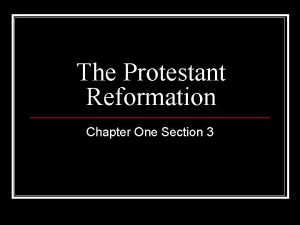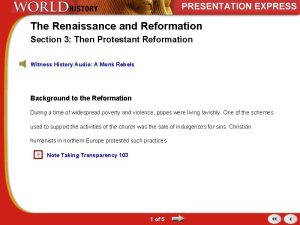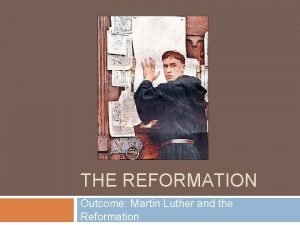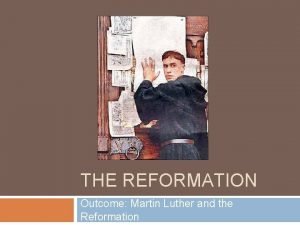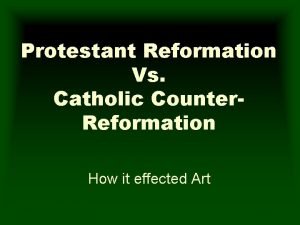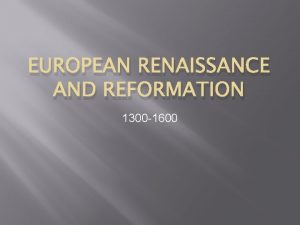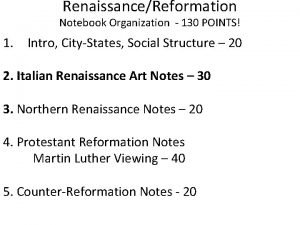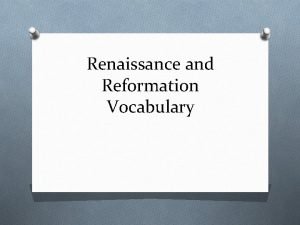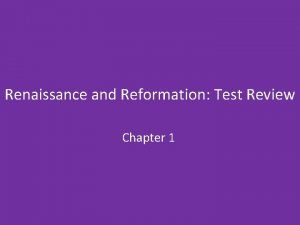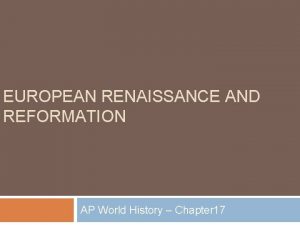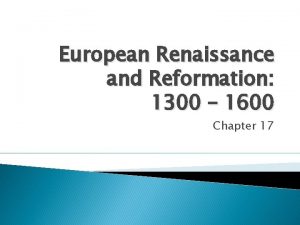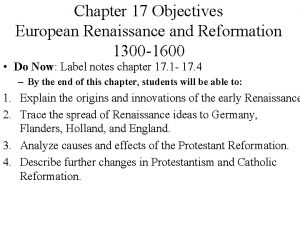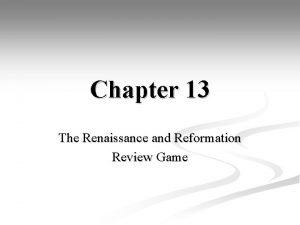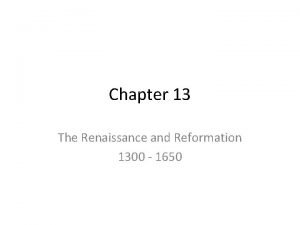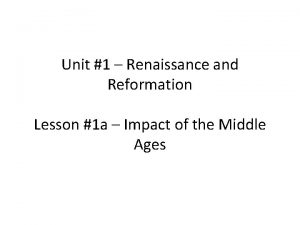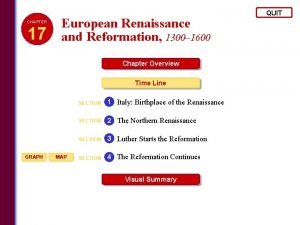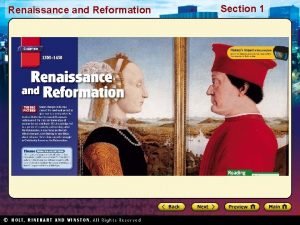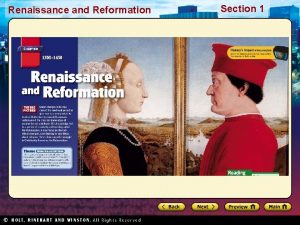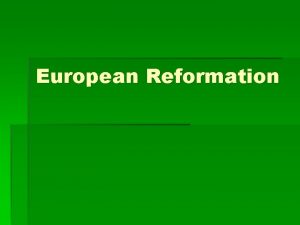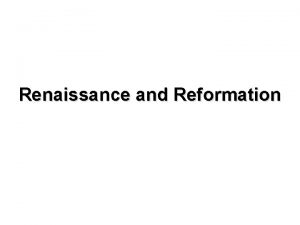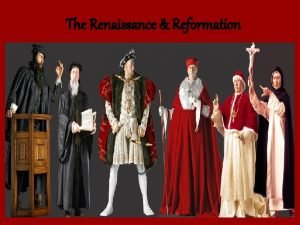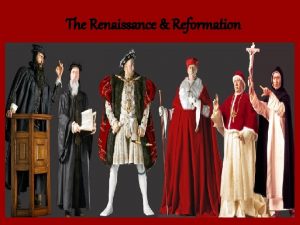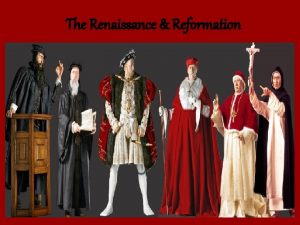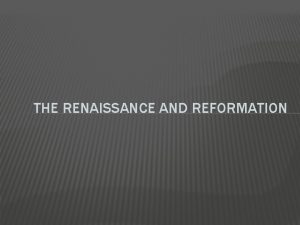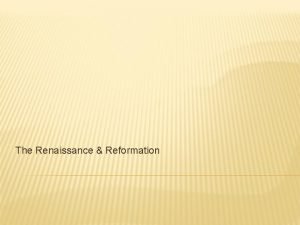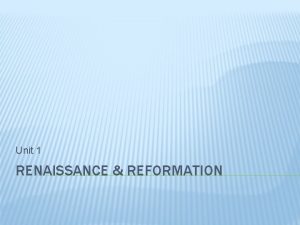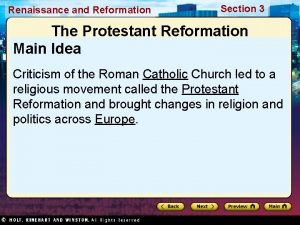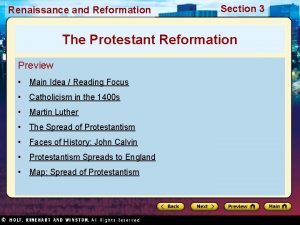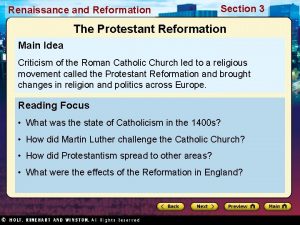Renaissance and Reformation Section 1 Renaissance and Reformation
















- Slides: 16

Renaissance and Reformation Section 1

Renaissance and Reformation Click the icon to play Listen to History audio. Click the icon below to connect to the Interactive Maps. Section 1

Renaissance and Reformation Section 1 The Italian Renaissance Main Idea In Italy the growth of wealthy trading cities and new ways of thinking helped lead to a rebirth of the arts and learning. This era became known as the Renaissance. Reading Focus • What changes in society and in cities stimulated the beginning of the Renaissance? • What ideas formed the foundation of the Italian Renaissance? • What contributions did artists make to the Renaissance?

Renaissance and Reformation Section 1 The Beginning of the Renaissance Michelangelo’s painting was different from the art of the Middle Ages, and only one way in which European society began changing after the 1300 s. The Rise of City-States • Urban areas specialized, particularly in Italy • Italy divided into several large city-states in north, various kingdoms, Papal States south • Catholic Church, nobles, merchants, artisans dominated society in city-states • Many sought to display new wealth with knowledge of arts

Renaissance and Reformation Venice • With access to sea, Venice built economy, reputation on trade • Had long history of trading with other ports on Mediterranean Sea • Shipbuilding prospered, sailors traveled to Near East • Wealthy Venetian merchants built unique city, “work of art” Section 1 Milan, Florence • Milan, west of Venice, based economy on agriculture, silk, weapons • Florence, to south, famous for banking, cloth • Monarchs appealed to Florentine bankers for money to fund wars • Merchants refined raw wool into fine cloth • Bankers, merchants created a city to rival any in Europe

Section 1 Renaissance and Reformation Renaissance Ideas As the economy and society changed, new ideas began to appear. This period of interest and developments in art, literature, science and learning is known as the Renaissance, French for “rebirth. ” Inspiration from the Ancients • Venetian ships carried goods for trade and Greek scholars seeking refuge • Scholars brought back ancient works thought to be lost New World of Ideas • Italians who could read looked for more information • Read Arabic translations of original texts • Searched libraries, found lost texts Different Viewpoints • As they read, began to think about philosophy, art, science in different ways • Began to believe in human capacity to create, achieve

Renaissance and Reformation Section 1 Humanism • Interest in ancient Greek, Roman culture • Scholastic education: rhetoric, grammar, poetry, history, Latin, Greek • Subjects came to be known as humanitiesknown as humanism • Humanists emphasized individual accomplishment • Roots traced to work of Dante; work contained glimpses of what would become focus on human nature • Historians believe Renaissance began with two humanists who lived after Dante— Giovanni Boccaccio, Francesco Petrarch • Both wrote literature in everyday language not Latin

Section 1 Renaissance and Reformation Secular Writers • Early 1500 s life in Italy seemed insecure, precarious • Church no longer served as source of stability, peace • Form of humanism developed from Petrarch’s ideas; focus was secular, was worldly rather than spiritual Renaissance Man • Ideal Renaissance man came to be “universal man, ” accomplished in classics, but also man of action, who could respond to all situations.

Renaissance and Reformation Section 1 Examples of Renaissance Men How to Act • Italian diplomat Baldassare Castiglione wrote book, The Courtier • Described how perfect Renaissance gentleman, gentlewoman should act • Castiglione gave nobles new rules for refined behavior in humanist society • Speak of serious, amusing subjects, know Latin & Greek • Be well-acquainted with poetry, history; be able to write prose, poetry How to Rule • Philosopher, statesman Niccolò Machiavelli also wrote influential book • Experiences with violent politics influenced opinions on how governments should rule in The Prince

Renaissance and Reformation Section 1 Machiavellian advice seemed to encourage harsh treatment of citizens, rival states • Describes men as “ungrateful, fickle, liars, and deceivers” • Advises rulers to separate morals from politics – Power, ruthlessness more useful than idealism – Ruler must do whatever necessary to maintain political power, even if cruel-“the end justifies the means” • Idea that state an entity in itself, separate from its ruler, became foundation for later political philosophy

Renaissance and Reformation Section 1

Section 1 Renaissance and Reformation Renaissance Art The arts a reflection of the new humanist spirit Medieval artists—idealized and symbolic representations Renaissance artists depicted what they observed in nature Patrons of the Arts • Medieval times, anonymous artists who worked for church created art • Renaissance artists worked for whoever offered them highest price • Buyers of art, patrons, might be wealthy individuals, city governments, or church Competition Among Patrons • Wealthy individuals competed, displaying wealth, modernity through purchase of artworks • Florence, Lorenzo de Medici supported most talented artists • Milan, ruling Sforza family benefactors of artists, others Renaissance artists wanted to paint the natural world as realistically as possible.

Renaissance and Reformation Leonardo da Vinci • Highly talented in all fields • His paintings are still studied and admired • Wrote out ideas, filling 20, 000 pages of notes • His interests, enthusiasm boundless Section 1

Renaissance and Reformation Michelangelo Section 1 Sculpture, Painting • Studied anatomy • Marble statue of David • Age 24, won fame with Pietà, sculpture of Jesus’ mother Mary holding son’s dead body • Most famous painting, artwork on ceiling of Sistine Chapel • Sculpture communicates grief, love, acceptance, immortality • Scenes from Old Testament considered one of greatest achievements in art history

Renaissance and Reformation The Pietà & David Section 1

Renaissance and Reformation Section 1
 The renaissance and reformation section 3 quiz answer key
The renaissance and reformation section 3 quiz answer key The renaissance and reformation section 3 quiz
The renaissance and reformation section 3 quiz The reformation outcome: martin luther and the reformation
The reformation outcome: martin luther and the reformation The reformation outcome martin luther and the reformation
The reformation outcome martin luther and the reformation Protestants vs catholic
Protestants vs catholic European renaissance and reformation
European renaissance and reformation Topic 4 the renaissance and reformation
Topic 4 the renaissance and reformation Renaissance and reformation interactive notebook
Renaissance and reformation interactive notebook Renaissance and reformation vocabulary
Renaissance and reformation vocabulary Chapter 1 renaissance and reformation
Chapter 1 renaissance and reformation European renaissance and reformation answer key
European renaissance and reformation answer key European renaissance and reformation chapter 17
European renaissance and reformation chapter 17 European renaissance and reformation chapter 17
European renaissance and reformation chapter 17 Chapter 13 renaissance and reformation
Chapter 13 renaissance and reformation Chapter 13 the renaissance and reformation
Chapter 13 the renaissance and reformation Unit 1 renaissance and reformation
Unit 1 renaissance and reformation European renaissance and reformation chapter 1 answer key
European renaissance and reformation chapter 1 answer key
